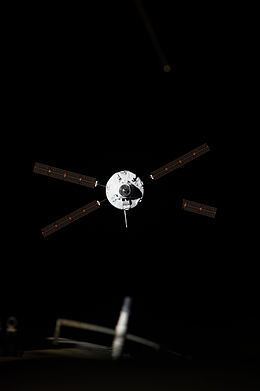Mission type ISS resupply COSPAR ID 2014-044A Spacecraft type ATV Inclination 51.65° Launch date 29 July 2014 | SATCAT no. 40103 Mass 6,555 kg Period 1.5 hours Rocket Ariane 5 | |
 | ||
Launch mass 20,293 kilograms (44,738 lb) Similar | ||
The Georges Lemaître ATV, or Automated Transfer Vehicle 5 (ATV-5), was a European unmanned cargo resupply spacecraft, named after the Belgian astronomer Georges Lemaître. The spacecraft was launched during the night of 29 July (23:44 GMT, 20:44 local time, 30 July 01:44 CEST), 2014, on a mission to supply the International Space Station (ISS) with propellant, water, air, and dry cargo. It is the fifth and final ATV to be built, following the Albert Einstein, which launched on 5 June 2013. Georges Lemaître was constructed in Turin, Italy, and Bremen, Germany. Cargo loading was completed in Guiana Space Center on 23 July 2014.
Contents
Georges Lemaître was launched on an Ariane 5ES rocket from the Guiana Space Centre in Kourou, French Guiana. The launch was conducted by Arianespace on behalf of the European Space Agency. This is the final planned launch of the Automated Transfer Vehicle.
Artist Katie Paterson sent artwork to the International Space Station aboard ATV-5.
Spacecraft georges lema tre atv
Mission payload
Georges Lemaitre ferried 6.6 tonnes of experiments, spare parts, clothing, food, fuel, air, oxygen and water to the ISS. In addition to the usual cargo ATV-5 performed 2 experiments:
LIRIS (Laser InfraRed Imaging Sensors) was a new autonomous rendezvous sensor set that allowed future ships to dock with uncooperative targets, like debris or sample capsules - Georges Lemaître used a demonstration version of it instead of standard optical sensors bouncing light off the reflectors around ISS docking port.
Break-Up Camera recorded ATV in infrared as it broke up performing atmospheric reentry above Pacific Ocean. After recording is completed reinforced SatCom capsule doubling as a black box began transmitting data to one of the Iridium satellites through the gap in plasma behind the vehicle. A message with information on the number of pictures taken – nearly 6000 – as well as accelerometer and magnetometer readings, details of the sphere rotation and a temperature reading was transmitted. After that first message no further data was transmitted.
Haptics-1 will be the first force reflecting Joystick to be used in space. The Haptics-1 joystick communicates in real-time with a space qualified tablet PC (Dell Latitude 10) to allow astronauts to perform a range of seven physiology experiments.
